![]()
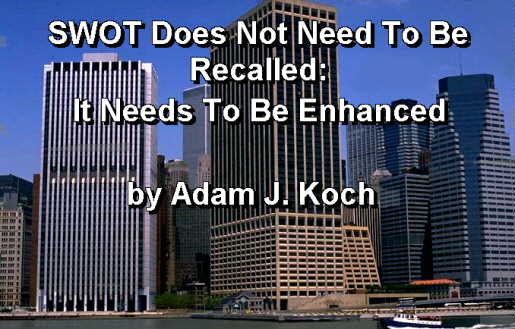
|
PART 2: FUNDAMENTALS OF ENHANCEMENT |
Adam J. Koch akoch@swin.edu.au is on the faculty of the School of Business, Swinburne University of Technology, Hawthorn, Victoria. Australia.
If you do not like the background color, you can change it by highlighting a color you prefer in the scroll box below.
|
Summary The review of SWOT malpractice undertaken in the first part of this paper has shown that a considerable improvement is needed in the way SWOT framework is understood, and used, by many organizations. To help organizations enhance their SWOT analysis six relevant rules are introduced by SECURE model of this analytical process and various SWOT quality aspects are discussed in the concluding part of this paper. |
Part 1, Description of the Problem , appeared in November 2000.
|
MAIN ENHANCEMENT AVENUES |
Conceived as a simple framework to be used mainly as a part of the situational analysis, SWOT has seen a few attempts to graft on to it some diagnostic capacity. Reported attempted enhancements of SWOT as a tool of strategic analysis include introduction of weighting, ranking and commenting upon the different factors that make up the SWOT lists. Prior to introducing the envisioned SWOT enhancement framework a range of previous SWOT development ideas by Weihrich (1982), Dealtry (1992) and Wheelen and Hunger (1998) must be presented.
Weihrich thinks of SWOT matrix as of 'a conceptual framework for a systematic analysis that facilitates matching the external threats and opportunities with the internal weaknesses and strengths of the organisation' (1982, p. 9). In his seminal paper he points out that if external and internal environments show high changeability the company should prepare an appropriate sequence of several SWOT/TOWS (1) matrices, rather than a single SWOT/TOWS pair, each of them applicable to a specific point in time, or period. Another of his suggestion is for companies to use Interaction Matrices to identify strong, weak and non-existent SO, WO, ST and WT matches (SO matches are those between the strengths of the company and external opportunities, and so on). Weihrich calls for a careful evaluation of all such relationships well beyond the scope of an Interaction Matrix. However, since the concept of Interaction Matrix does not appear to have been widely adopted in situational analysis, some of the designed capacities of SWOT and other related tools introduced by Weihrich have largely been unutilized.
Wheelen and Hunger (1998) consider SWOT analysis the simplest way to conduct environmental scanning. They suggest that SWOT analysis should result in the identification of a company's distinctive competencies, and of opportunities that the company is unable to take advantage of due to a lack of, or insufficient, current resources.
Dealtry (1992) suggests that in appraising effects of opportunities, threats, strengths and weaknesses, emphasis should be put on their combined effects, rather than on the effects of individual factors in isolation from one another. He proposes that balances between coinciding opportunities and threats, and strengths and weaknesses, be studied by each organization to determine the direction of Strategic Vectors designed to inform strategy formulation as to the relative importance of the ascertained groups of factors (Ss, Ws, Os and Ts) for the organization. Dealtry encourages reflection on the influence of the corporate culture on the identification of strengths and weaknesses. In further developing the original Weihrich's proposal, he suggests that three separate SWOT inventories be developed by companies, one based on the current situation, one pertaining to the immediate future, and one concerned with a more distant horizon.
Certain directions of SWOT enhancement could appeal to a wide spectrum of companies while other can make more sense in specific organizational contexts. Some organizations may need to develop their human resources by a fair margin, improve their planning procedures and their market intelligence to make the desirable SWOT enhancement possible.
An enhanced situational analysis is likely to require much more time than its simpler, less systematic forms. To avoid impossible, or excessive, time demands on those involved in strategic analysis, many organizations may need to find more efficient ways of doing SWOT.
|
DEVELOPING THE SWOT FRAMEWORK |
Commonality of various SWOT malpractices as discussed in the first part of this paper shows that appropriate rules must be developed and observed in every SWOT analysis if it is to produce reliable inputs into strategy generation. SECURE model developed by this author introduces the six relevant rules shown below in Figure 1.
FIGURE 1
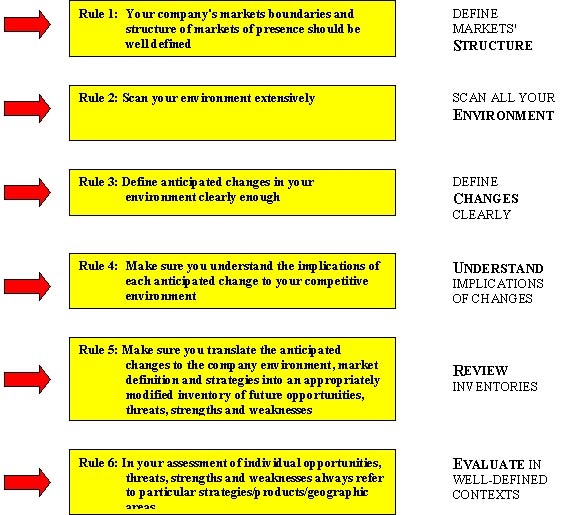
The first rule is that boundaries and structure of the market, and their anticipated changes, should be well defined. The following example illustrates this need eloquently. On recognizing the potential of digital imagining, Kodak redefined its mission statement in early nineties from one that emphasized its traditional role in the photo-imaging industry to one that brings out the need to 'provide [their] customers and consumers with solutions to capture, store, process, output, and communicate their images to people and machines anywhere, anytime' (Eastman Kodak Web Page 1995). Kodak Digital Images technology was introduced to give customers an opportunity to experiment with, an enhance images on their computers. This shift in emphasis would have affected the composition of Kodak's SWOT inventories and the ranking of individual items contained there. One can surmise that Kodak's capacity to supply its customers with technologically superior digital enhancement software would have become quite important, as a result of the presented strategic change. On the other side, its capacity to further enhance the quality of the traditional films may have become somewhat less important for the company.
The second rule demands that all changes in the company environment capable of influencing this company future performance be included in its SWOT analysis. One should stress here that a multiple-scenario approach to strategic planning would require a multiple SWOT inventory development at each, or at least some, organizational levels.
The third rule, trends in the company’s external and internal environments should be presented clearly. If, for instance, the long-term survival of the automotive industry depends on its adoption of a new propelling system for a future car, a system that would be more environmentally friendly, and increasingly based on renewable, or more abounding, sources of energy [2], a superior ability of car-making companies to make progress in this direction would be of critical strategic importance today.
The fourth rule, company's competitive environment(s), their structure, forms, scope and intensity of competition should be properly examined and presented. Again, one should aim for precision of reference in all these respects. For instance, referring broadly to a company as one ‘involved in telecommunication’ may be quite inadequate, while referring to it as ‘involved in facilitating transmission of [certain kind of data] to [certain categories of customers] in [certain geographic regions]’ will make it possible to ascertain, and name, all possible opportunities, threats, strengths and weaknesses. Aiming for a high level of precision in making one’s reference sufficiently specific should not come, however, at the cost of blurring the big picture of the market. One should always try and make sure that strategic analysts overlook neither trees nor woods.
The fifth rule, a clear reference to an anticipated state (anticipated states) of the future company internal and external environment should be made. If SWOT analysis is done in absence of such a background, the verification of claims concerning individual strengths, weaknesses, opportunities and threats can be either difficult or virtually impossible. Thus, organizations need to formulate their possible future scenarios clearly and completely. Analysis of the potential significance of the various organization strengths and weaknesses in various possible future situations is obviously capable of enhancing SWOT analysis quite considerably. Fahey and Randall stress the crucial importance for the quality of strategic planning of what they call scenario learning defining the latter as a 'combination of strategic management and scenario technology [and] a collection of teamwork, creativity and decision making skills' (1997, p.IV).
The sixth rule, a clear reference to future strategic objectives and strategies is required in every SWOT analysis. Failure to do so will make the evaluation of scenario-specific relative importance of individual strengths, weaknesses, opportunities and threats quite perplexing and much harder, if at all feasible. One should acknowledge that their significance depends, among other things, on what strategies are going to be implemented by the company.
One very important conclusion emanates from the requirement to always do SWOT analysis on a strategy-specific basis. For SWOT to lead to the selection of an optimal strategy, analysts may need to consider verifying the proposed general SWOT inventory for each alternative strategy generated via TOWS matrix [3]. Subsequently, necessary modifications need to be introduced to all strategy-specific inventories, evaluated and verified. The outcome of this process will be, as shown in Figure 2 below, a class of m inventories for m strategies to be implemented by the company [4]. These will, as a rule, differ between themselves both in composition and the ranking of inventory items.
FIGURE 2
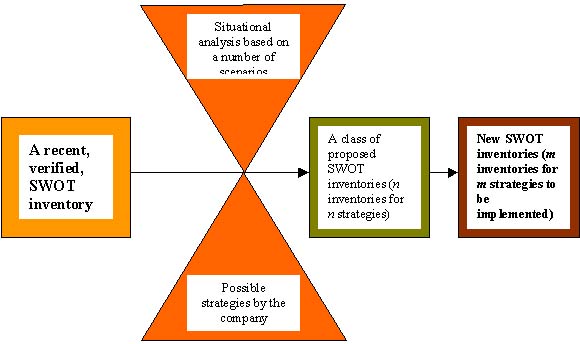
|
ELIMINATION OF INFORMATION GAPS |
Information gaps can occur in all areas covered by SWOT analysis. However, they are most often encountered in the following areas:
Operational definitions [5] of key success factors (KSFs) for the industry and the company (rendering these definitions incomplete, too general, or unverifiable); take, as examples, the following vague references to 'strong finance, R&D or corporate culture' that are proposed as KSFs;
Aspects of competitive performance pertinent to individual KSFs (some aspects may not be examined at all, or examined in a less than reliable way); for instance, information about competitors' customer retention rates;
No projections made of the anticipated competitive performance over the planning horizon;
No verification of the validity of the proposed inventory, or inventories, of strengths and weaknesses with respect to various strategies contemplated; and
No suggestions made concerning the significance of individual strengths and weaknesses for the success of particular products/ services sold by the company.
The main reasons responsible for the above information gaps are:
General unavailability and/or inaccessibility to the company of some information needed to complete SWOT analysis;
Low status of, and a correspondingly low commitment to, strategic analysis in the company;
Inadequate structure and poor performance of strategic management systems in the company; and
Failure to recognize the significance of some areas of company performance for its strategic success.
It is a common knowledge that in countries, and industries, where business information systems and services are well developed, organizations need less time to obtain most if not all the information needed to conduct their situational analysis. At the company level, information gaps are more likely to exist in organizations whose information gathering patterns are more haphazard than in those that have the support of a well-designed information system that enables a systematic information gathering. Organizations that operate under considerable competitive pressure will be motivated more strongly to use higher quality data and produce in their audits a more complete coverage of their internal and external environment. This will be the result of the need to secure a high quality of strategic response in the face of anticipated serious competitive challenge.
Time limitations imposed upon SWOT analysis are often quite unrealistic. This is bound to produce some methodological sloppiness and provides an excuse to cutting many respective corners. Such an approach would be, one should think, more common with:
Organizations that have inadequate resources to proceed with SWOT according to their needs;
Organizations that lack the level of experience and skill required to complete the relevant analytical tasks more swiftly;
Organizations that plan poorly; and in case of
Environments that undergo rapid change.
Some common miscomprehensions regarding the SWOT analysis, in particular those concerning its role in strategy generation, are likely to lead to information gaps. Those who do this kind of analysis are likely to underestimate the height of the associated hurdles unless they have undergone a proper training and see what kind of information and level of detail are required there. If sufficiency of SWOT inputs is verified only rarely, or not at all, by those possessed of superior level of strategic management, or strategic marketing, competence, most information gaps are likely to remain unnoticed and subsequently produce invalid and/or unreliable outcomes of situational analysis.
For similar reasons, when SWOT analysis is done in haste and produces unreliable results, using SWOT outputs to generate strategies would be improper. A substantial body of evidence obtained by this author in the course of his postgraduate teaching involving business executives suggests that a strong positive relationship does exist between inadequate preparation and conduct of SWOT, and the subsequent failure to use SWOT results as inputs to strategy generation.
Another associated relationship also reported in the literature is a management's repeated failure to make an appropriate use of SWOT: such situation is bound to eventually weaken the motivation and reduce the diligence of those involved in strategy analysis. With some, the SWOT may indeed be the epitome, as Hill and Westbrook (1997) report, of what they believe to be the inadequacy and futility of strategic planning. In their eyes, strategic planning may have become a (rather fanciful) goal unto itself. Whenever such views get formed, the organization may find it difficult to achieve any significant enhancement of its strategic management performance.
Finally, certain kinds of information are notoriously difficult to get. A common kind of gap would be sparse information on the performance of competing companies, including areas and parameters of critical significance. Typical examples thereof would include comprehensive data on the longevity of parts of competitors' machines/equipment, their customer retention rates and detailed cost calculations.
|
UPDATING SWOT INPUTS |
If companies fail to follow, or properly interpret, changes in their competitive environment, they increase the risks of omitting some of their critical performance parameters, or using inadequate inputs in their analysis. Some companies simply fail to modify composition of the critical performance parameters according to the change occurring in their environment. They either remain blind to the impact of the change on the scope and patterns of competition in their industries, or fail to use this knowledge to modify the list of the critical performance parameters.
Yet, in a very dynamic environment bringing all information up to date may turn out quite difficult, if not impossible. One of the crucial parameters to determine this outcome would be the amount of time it takes for the company to note and make sense of all changes to its external and internal environment. Figure 3 below presents all the major factors that influence the need to update SWOT inputs. The availability of, and accessibility to, all necessary information by the company is one of those. How often SWOT gets done and the scope of SWOT reviews are two other important factors. Finally, one should also note that there often are specific obstacles and limitation to SWOT update with regard to various kinds of information. Take, for instance, the limitations resulting from the length of intervals for censuses.
FIGURE 3
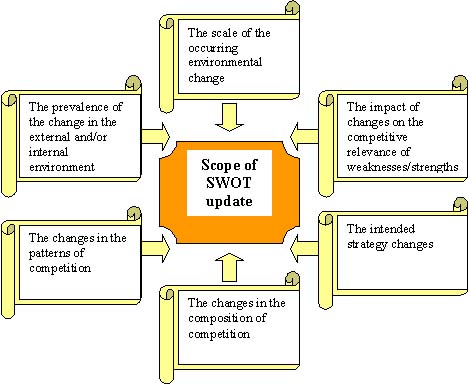
If the scale of an environment change is only minor and very gradual, the scope and complexity of the updating task will be manageable for most companies. However, if changes in some environment areas become more dramatic, they may demand a complete review of the most recent SWOT inventory to examine the relevance and currency of all items.
In case of a major change causing, or anticipated to cause, a significant discontinuity in the existing patterns of, or in the composition of competition, companies will experience major difficulties and take long time to bring their SWOT inventories up to date. Making sense of any commencing large, discontinuous change, forming a view with regard to possible competitive implications and strategic responses by all major participants and then achieving consensus between those performing relevant strategic analysis tasks will always pose tremendous challenges.
Changes in the company environment can be limited to some sectors, e.g. aspects of logistics, or manufacturing technology. Sometimes they may however affect most, if not all, parts of that environment. Take Internet: since its advent in early nineties, the efficiency and comprehensiveness of the global business information gathering effort has improved with most companies dramatically. The pace of global information dissemination, efficiency of one-on-one market communication, effectiveness of market segmentation and numbers of niche marketing options available have been amongst the areas that have experienced most change.
Theory discerns two basic competitive patterns: that based on cost advantage, and that based on product/service differentiation [6]. However, when one considers specific competitive structures and patterns that prevail in particular product markets and geographic areas that make up these, surely incomparably richer, and different, tapestries emerge of particular scopes, forms and patterns of competition.
Changes in the company environment often lead to the emergence of new competitors and disappearance of some old ones. Indeed, some changes in the company environment may be directly linked to these two. Whilst some of these may be obvious in the eyes of most, some other may take a superior perception for them to be promptly ascertained as market facts relevant to the company. For instance, if a superior, less expensive material/technology was discovered today that would be applied in optic fiber cables production and system development, this would in all likelihood have a considerable significance for the future of cinemas, as highly efficient video lending on a massive scale would be possible much sooner. Relevance of developments in the areas that are not covered by routine strategic analysis may easily be overlooked.
For the strategic analysis to offer a reliable basis on which to develop most promising new strategies, it is vital that all significant implications of environment changes for the company are ascertained. This would often require a high level of diligence. All substantial changes to the company external and internal environment require that all former critical competitive leads and gaps be reviewed and, if need be, re-defined appropriately. Once again, it may be necessary to emphasize here that without considering various possible scenarios, as well as new corresponding objectives and strategies, strategic analysis is incomplete and unreliable.
The importance of evaluating strengths and weaknesses for each strategy (and product) separately may still need to be emphasized, as some examples of SWOT analysis would attest. Composition of such specific SWOT inventories and the relative importance of individual items will in many instances show significant discrepancies. Compare main flight control computer on a manned spacecraft with a simple computer for household use. Surely, the former will require a much higher reliability and hugely increased information processing capacity than the latter. Yet, the same company may manufacture both kinds of equipment.
If the external, or indeed internal, environment of company becomes quite unstable, the challenge rises for the company to not allow the potential SWOT inputs get out of date. Two particular aspects of this challenge need to be stressed here:
The need to collect and communicate promptly all information about the changes to all who are to be involved in SWOT analysis; and
The need for enough reflection to occur before SWOT participants can provide valid inputs into the modified SWOT.
Meeting these two requirements may require considerable amount of time and extra skills to be developed by individual companies. Improving forecasting and information interpretation capacity through training and management system enhancement will in many cases help companies meet their particular challenges to bring all of their strategic information up to date.
|
OTHER INFORMATION QUALITY ISSUES |
As is shown below in Figure 4, the factors that have just been discussed, quantity and the recency of supporting evidence, represent only part of the overall influence on the quality of SWOT analysis.
FIGURE 4
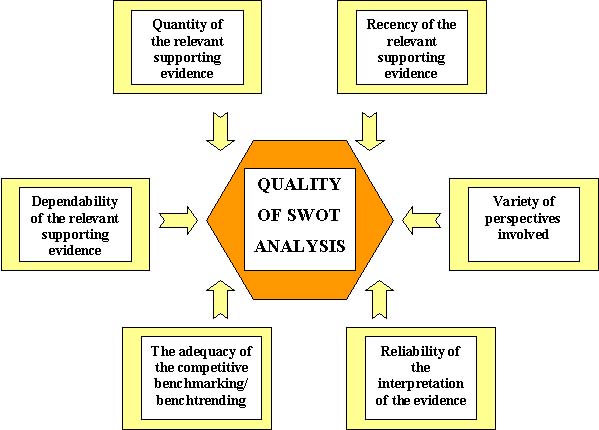
The impact of all remaining factors must now be briefly apprised.
First, such influence may come from insufficient evidence supporting individual SWOT propositions. Evidence obtained by the author from his postgraduate teaching suggests that this may be quite common a situation in strategic planning.
Second, evidence provided in SWOT analysis will be more dependable if it is properly verified, and sufficient to answer all important questions one can ask about the collective impact of various co-existent elements of environment on the current, and future, competitiveness of the company. Any extensive scrutiny of strategic analysis practice is certain to produce many examples of absence of, or deficiencies in, the verification of SWOT evidence.
Some companies tend to overstate either their strengths or, less commonly, their weaknesses (Hill and Westbrook 1997). Further, some analysts may not see certain opportunities, while some other, put in their position, will. The same applies to threats facing a company.
Third, reliability of the interpretation of any SWOT evidence will largely depend on:
The proper understanding by all participants of the role and limitations of SWOT analysis;
The scope of participation and the variety of perspectives and backgrounds of those involved;
The amount, and quality, of scrutiny in verifying all inputs; and
The proper level of diligence in generating various likely scenarios and strategic options for the company.
Fourth, involving a wide variety of perspectives and backgrounds by staff and stakeholders will make blind spots and distortions in SWOT evaluations less likely due to the specificity of experience, or various divisional/departmental interests represented.
|
CONCLUSION |
The exploration of problems related to SWOT implementation undertaken in the first part of this paper has shown that SWOT should continue to be regarded as a most essential element of strategic analysis. If applied appropriately, through people who show the necessary diligence and have the intellectual rigor to undertake their strategic management tasks, SWOT is bound to produce meaningful and valid results. Interestingly, for all their criticism of SWOT, Hill and Westbrook recognize it when they write that SWOT could ‘still be valuable if undertaken with more rigour, challenging of assumptions and subsequent validation and investigation’. (1997, p. 51). Surely, SWOT can be an excellent, very efficient, and simple tool facilitating exploration of strategic alternatives for the organization through a systematic introspection into both positive and negative concerns. To produce fully reliable results, however, SWOT analysis must be flexible and inventory updates made frequently (Balamuralikrishna et al 1998).
Laying bare all the misconceptions about SWOT is the surest means of ensuring SWOT's endurance as a framework, and a tool of strategic analysis. SWOT does not have any inherent qualities, which could, of their own, ensure that the strategic analysis based on it is conducted with necessary rigour. SWOT analysis will not, as already mentioned, produce meaningful and valid results if no clear reference is made throughout the situational audit to specific organization levels and products as well as current and contemplated strategies. As an input to strategy generation, SWOT inventories must be based on the anticipated, rather than current, levels of competitors' performance in key areas. Finally, for SWOT to have a superior level of validity, situational analysis should be conducted on the international, rather than a local, basis and consider possibility of new competitors entering from other product-markets and industries.
Commonality of SWOT misapplication points to the existence of a general problem: that of the quality of strategic management design and implementation. Given the evidence available to this author, many organizations require a considerable enhancement of their strategic management systems and individual strategic practices and tools. Properly operationalized dimensions such as a company's strategic management responsiveness, efficiency and effectiveness (Koch 1999) could be considered as yardsticks with which to measure the relevant improvement. The effectiveness of such modifications will depend, on one hand, on the soundness of the proposed new approaches in various organizational contexts; on the other - on the quality of their implementation.
The disenchantment with SWOT signaled by some academics and by business practice has been found in this paper largely unjustified or ill addressed. SWOT is likely to be around as the framework of strategic situational analysis for a long while. Its condition, however, will depend on the diligence and skills of its users, on their understanding of SWOT's role in strategic analysis, and on the commitment of organizations to enhance their strategic management.
END NOTES
1. TOWS serves to generate strategies based on some of the previously recognized SWOT inventory items: see e.g. David (1997), pp. 180-184; to avoid a possible confusion one should note, however, that the original nsme given by Weihrich to the SWOT matrix was TOWS; it has been subsequently changed to SWOT (e.g. David 1997).
2. The 1997 launch by Toyota of Prius could be used as an example of such a trend. Prius is equipped with a hyper-clean 1.5l gasoline engine coupled with 30-kilowatt electrical motor. The latter starts and accelerates the car as well as supports the engine during a high speed cruising. The engine automatically shuts when vehicle is at a standstill, and kinetic energy is regenerated into electro-energy during deceleration.
3. The suggestion to develop a number of modified inventories for each contemplated strategy needs to be tested by each company for its feasibility as well as for the balance of anticipated benefits and costs associated with such an extension of SWOT analysis.
4. To simplify this part of discussion we assume that the class of m strategies represents all instances of product-specific responses to the contemplated strategies; otherwise we would have to add another dimension here, to account for anticipated various sensitivity of individual products/services sold by the company to various contemplated future strategies.
5. For a definition of a KSF to be considered operational, it has to be detailed and accurate enough to be a reliable basis on which to suggest, and evaluate the influence of the presence (or absence) of such a KSF on the outcomes of a certain strategy.
6. The most popular classification by Porter (1980) includes three categories of viable generic competitive strategies: those based on overall cost leadership, those based on differentiation and those based on the principle of focus; in this discussion, the last one will be omitted as it can be shown to be based, unlike the two former ones, on more than one basic principle.
SOURCES
Hill, T. and R. Westbrook (1997). "SWOT Analysis: It's Time for a Product Recall". Long Range Planning, Vol.30, No.1, pp. 46-52.
Koch, A. (1999). "Strategic Management System Enhancement and the Concept of Strong Influence Strings" In: Managing Complexity in Organizations: A View in Many Directions, pp. 217-239. Edited by M.R.Lissack and H.P.Gunz. Quorum Books, Westport, Conn
Learning from the Future: Competitive Foresight Scenarios (1997). Edited by L. Fahey and R.M.Randall, John Wiley and Sons, New York.
Porter, M. E. (1980). Competitive Strategy: Techniques for Analyzing Industries and Competitors, Free Press, New York.
Wheelen, T.L. and J.D.Hunger (1998). Strategic Management and Business Policy, 5th edition, Addison-Wesley, Reading, MA.
Weihrich, H. (1982). The Tows Matrix - a Tool for Situational Analysis, Long Range Planning, April 60.
American spelling, which in some cases differs from that used in Australia, has been used in this article.